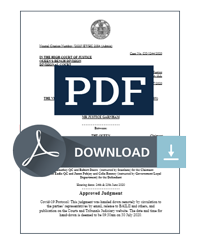Notes published by Felicity Gerry KC
Case notes from Sarah Day and Marie Spenwyn providing an update as to recent key sentencing developments including a significant case affecting imposition of custodial sentences given capacity in prisons, approach to sentencing those who are sentenced when adults offending committed when a child and new sentencing guidelines.
Prison population and sentencing:
Summary of recent Statement from the Chairman of the Sentencing Council
The Chairman of the Sentencing Council, Lord Justice William Davis, has recently issued a statement in relation to concerns over the high prison population, following the Court of Appeal’s judgment on 3 March 2023 in R v Arie Ali [2023] EWCA Crim 232. The case of Ali clarifies that when sentencing an offence that crosses the threshold for a short custodial sentence where there continues to be pressure on prison capacity, as there is at present, the courts can take into account the impact of the current prison population levels to determine whether to suspend a sentence or impose a community order as opposed to a short custodial sentence. Quoting a letter from the Deputy Prime Minister to the Lord Chief Justice in February 2023, the judgment highlights that operating close to prison capacity has consequences for the conditions in which prisoners are held. Most particularly, they may well be further away from home (affecting the ability for family visits), be in crowded conditions and have reduced access to rehabilitative programmes.
Both the case of Ali and the subsequent statement by the Chairman make clear that the high prison population is an additional factor which can be taken into account when deciding whether a short custodial sentence must be imposed immediately or whether it can be suspended. It is not a factor which requires all short prison sentences to be suspended, as ever, that must be based on all the factors pertinent to the sentencing exercise. It would appear that the courts will be reliant on the government to communicate when prison conditions have returned to a more normal state.
As a final note, during a recent sentencing exercise in front of Lord Justice Edis sitting at Nottingham Crown Court, he indicated that the issue was only in relation to the male prison population. It is notable, however, that the statement from the Chairman is not limited in that way so it remains to be seen how this will be applied throughout the courts.
Sentencing adults for offences committed when a child
From the 17th March 2023 R v Ahmed [2023] EWCA Crim 281 is an important judgement in which the Court of Appeal has clarified the approach that must be adopted when sentencing an adult for offences committed as a child. In this case, the court heard five appeals together, which each concerned sexual offences and in which the question the court sought to resolve was the correct approach to sentencing an adult for an offence committed as a child. Each of the five sentences were reduced by the Court of Appeal.
A number of principles for sentencing those who offended as children but are sentenced as adults can be distilled (at paragraph 32):
- The Court rejected the submission of the respondent that the Sentencing Council’s Overarching Guideline on Sentencing Children and Young People can only be applied where there is “relative temporal proximity”. The Court confirmed that whatever the age of the offender at the time of conviction and sentence, the Overarching Guideline is relevant and must be applied (in accordance with Section 59(1) of the Sentencing Code) unless the court is satisfied it would be contrary to the interests of justice to do so.
- The court must have regard to the maximum sentence which was available at or shortly after the time of the offending.
- The court must take as its starting point the sentence which it considers was likely to have been imposed if the child offender had been sentenced shortly after the offence.
- If in all the circumstances of the case the child offender could not in law have been sentenced (at the time of his offending) to any form of custodial sentence, then no custodial sentence may be imposed;
- Where some form of custody was available, the court is not necessarily bound by the maximum applicable to the child offender. The court should, however, only exceed that maximum where there is good reason to do so. The Court emphasised that the mere fact that the offender has now attained adulthood is not in itself a good reason. The Court further stated they found it very difficult to think of circumstances in which a good reason could properly be found, and thus respectfully doubted the decision in the case of R v. Forbes and others [2016] EWCA Crim 1388 in this one respect. However, the point was not specifically argued in these appeals and so the Court has indicated that a firm decision about it must therefore await a case in which it is directly raised.
- In each case, the issue for the court to resolve will be whether there is good reason to impose on the adult a sentence more severe than he would have been likely to have received if he had been sentenced soon after the offence as a child. The starting points taken as set out in the points above, may not necessarily be the end point of sentence as they may increase or decrease. As the court is sentencing an adult, it must have regard to the purposes of sentencing set out in section 57 of the Sentencing Code.
This case adds to a line of authorities from the Court of Appeal in cases such as R v Ghafoor [2002] EWCA Crim 1857 which emphasise that those who offend when under 18 should be treated differently from those who offend as adults and reviews them in the light of the overarching sentencing guidelines for children now in place since July 2017. The Court stated that this is in recognition of the fact that “in general, children are less culpable, and less morally responsible, for their acts than adults” as stated in R v Limon [2022] EWCA Crim 39. They therefore require a different approach and are not to be treated as if they were “just cut-down versions of adult offenders”. Of significance is the expression of these principles as applicable not only to cases where the offender has relatively recently crossed the threshold to adulthood, but where an adult is being sentenced – potentially decades later – for offences committed as a child. It is no doubt therefore that this will be a significant guideline case and of assistance to practitioners facing a sentencing scenario where the offender has either recently crossed the age threshold and must be sentenced as an adult, or whether the offending was historic offending which took place when a child and is of particular application to sexual offences.
New guidelines on sentencing for sale of knives to persons under 18 in force
Since the 1st April 2023 two new guidelines relating to the sale of knives by individuals and organisations (offences under s141A of the Criminal Justice Act 1988) to those under 18 have been in force. In circumstances where there had not previously been any guideline in place for these offences (punishable by a fine for organisations but with a maximin of 6 months imprisonment for individuals) the new guidelines are designed to allow for more consistency in the approach to sentencing these offences across the courts. There is one level of harm recognised the same risk of harm (to individuals and the wider community) is risked in relation to every sale. The offence is a summary only one in either case. The guideline for organisations includes specifics as to how they implement training and measures to verify age both in person and online. The sentencing ranges for organisations now provided will likely result in higher fines being imposed. As stated in the forward to the published response to the consultations these offences are not frequently prosecuted but have the potential for serious consequences. For offences that concern large quantities of knives of where there is ‘deliberate or reckless marketing of knives to children’ the guidelines would not apply.
New guidelines on sentencing child cruelty
Also in force from the 1st April 2023 is a guideline that updates those previously in force from 2019 specifically to take account of the change to the maximum sentences resulting from the Police, Crime, Sentencing and Courts Act 2022 applying to offences committed after the 28th June 2022. There is now a new level of “very high culpability” relating to both causing or allowing the death of a child (now life imprisonment) and causing or allowing serious harm/child cruelty (now 14 years).


